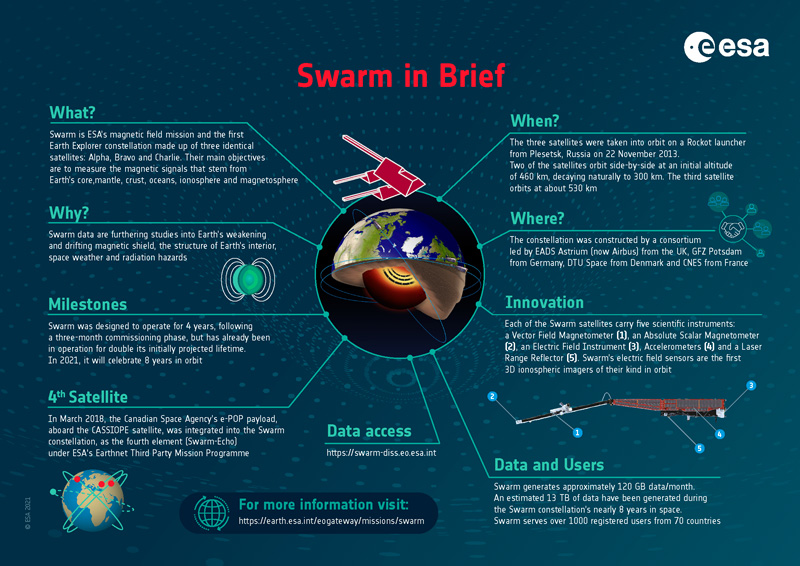- Learn & Discover
- How Swarm is helping scientist...
How Swarm is helping scientists study the ionosphere
29 Oct 2024
A team of scientists has used Swarm data to refine a model that helps predict the behaviour of the ionosphere. This layer of Earth’s atmosphere plays a key role in communications and navigation.
Located about 60 to 1000 kilometres above Earth’s surface, the ionosphere contains electrically charged particles. These particles influence the propagation of electromagnetic waves, such as radio signals, making the ionosphere an important factor in long-distance radio communication. It also plays a crucial role in the functioning of everyday navigation systems.
Navigation signals sent by Global Navigation Satellite Systems – such as Galileo or GPS – must pass through the ionosphere before they reach Earth. When they do, the ionosphere's charged particles can interfere with the signal and delay it, causing a timing error, or scatter the signal, causing a positioning error.
For this reason, scientists and engineers work on so-called ionosphere models to describe and predict the behaviour of the ionosphere. Now, in a study published in Atmosphere, researchers used improved Swarm datasets to get finer results in an effort to improve how we study this important layer.
“To perform this study, Swarm data were valuable because they are continuous, reliable, have a good time resolution and cover a full solar cycle,” says Michael Pezzopane, study co-author and researcher of the Italian National Institute of Geophysics and Volcanology.
The team focused on a model called NeQuick, which is particularly popular for studying the ionosphere. The model provides a 3D description of the ionosphere, predicting electron density as a function of altitude, geographical location, time, solar activity and other parameters. The model is popular for its efficiency in estimating the total electron content, an important metric for correcting errors in satellite navigation systems caused by ionospheric disturbances.
Despite its popularity, NeQuick struggles to model the entire ionosphere, especially its upper part. In a 2019 study, scientists introduced a new analytical formulation for one of the parameters on which the NeQuick model is based, to try and describe part of the electron density profile of the upper layer of the ionosphere. Now, Mr Pezzopane and his colleagues have gone one step further.
By using more comprehensive datasets and using Swarm-calibrated data, they found improved performance of the NeQuick model in representing the upper part of the ionosphere at mid and low latitudes.
The Swarm dataset allowed coverage of low solar activity conditions that were previously missing from the 2019 study. Swarm was useful to the team thanks to the Electric Field Instrument it carries. This instrument characterises the electric field around Earth and provides measurements of electron density, helping scientists to better study the ionosphere.
Swarm is part of ESA’s Earth Explorers. These are pioneering research missions tasked with unravelling key information about Earth’s processes.
Launched in 2013, the Earth Explorer Swarm mission consists of three identical satellites, two of which fly close together and a third at a different altitude. Swarm was designed to operate for four years, following a three-month commissioning phase. In November 2017, the mission was granted a four-year extension to 2021. It was then extended further and will operate till 2025.
